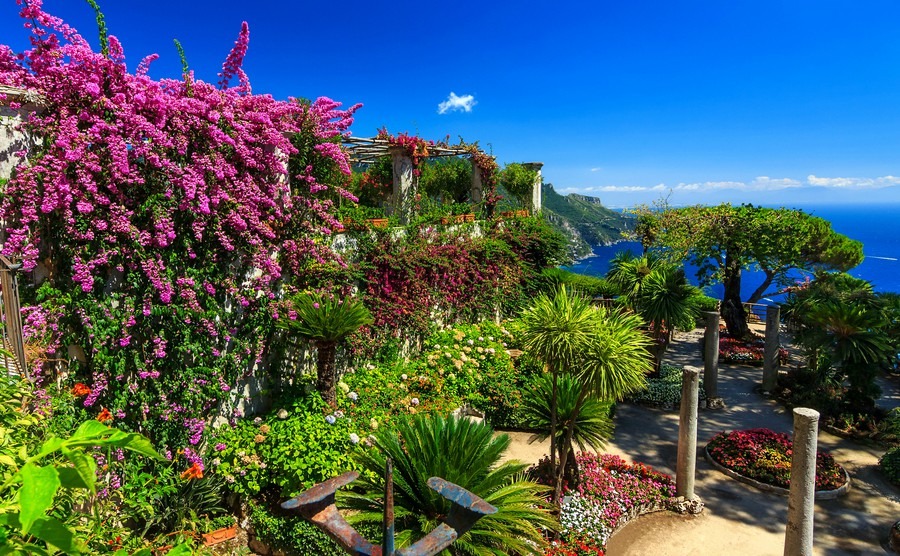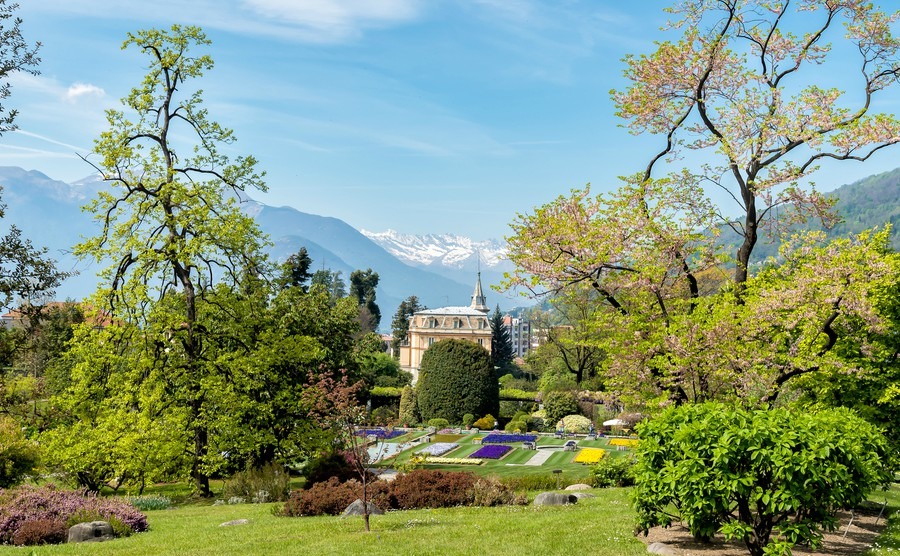If you’ve watched Monti Don’s Italian gardens on TV, or seen photos of an Italian palace, farmhouse and lakeside gardens, you might be looking forward to having an Italian garden of your own.
Visiting gardens in the area you plan to live can be a great design inspiration and gives you the opportunity to see which plants do well in that region. It’s also a good idea to look at what is flourishing in your neighbours’ gardens. In the countryside, Italians are more interested in growing plants that produce something edible, such as fruit, nuts, olives and herbs and even in the most elegant historic gardens you will find small fruit trees in large terracotta pots.
The garden should be in harmony with and compliment the features of the house and the landscape around it
Great Italian Gardens
This year is the twentieth anniversary of Grandi Giardini Italiani (GGI), which in English translates to Great Italian Gardens. GGI is Italy’s largest network of maintained historic gardens, which includes some of the most prestigious estates, covering around 500 years of horticultural history. The network was founded in 1997 by an English woman, Judith Wade, who after studying art history in Florence in the 1970s decided to make Italy her home. The venture began with 12 gardens, and now 20 years on it includes 125 estates in 12 regions, including the gardens of the Vatican, Sacro Bosco di Bomarzo in Lazio, Villa Taranto at Lake Maggiore and Giardino di Villa Gamberaia in Tuscany. The Great Italian Gardens now attract more than eight million visitors a year, which has helped many of the big estates to survive and brings tourist business to the surrounding areas. You can see the selection of gardens on the website, Grandi Giardini Italiani.

Villa Rufalo, Amalfi coast
Italian Renaissance gardens are known for having evergreens manicured into geometrically shaped hedges and topiaries. Although now mainly green in colour they would have framed flower beds that created colour and drama within the ordered design of the hedges and pathways. The elegant paths draw you to view sculptures, fountains, grottoes and areas to entertain and impress guests. Beyond the more formal planting it is also possible to have trees and hedges in many shades from silver greys through to shades of gold. The tall slim Italian Cypress and Juniper can stand proudly along the border or driveway of any large Italian garden, and even if your own garden is rather less grand you can still incorporate some of the planting ideas.
We have hundreds of homes for sale in Italy with amazing garden potential. Click your green fingers here to have a browse through our property listings!
Part of the adventure of moving to Italy is to discover how the local stone, landscape, soil and weather, influences the design of the houses and gardens. Whether you have a large balcony, terrace, courtyard or garden, they become extensions of the home and can have functional areas for dining, relaxing, cooking and bathing. The garden should be in harmony with and compliment the features of the house and the landscape around it. It’s great to discover plants that do well in your new garden that wouldn’t survive in the UK. You soon begin thinking like a local and start growing plants that not only look good but also taste good. An Italian garden is a joy to the senses, with the aroma and tastes of fruit, herbs and flowers, and the sound of bird song.
It’s great to discover plants that do well in your new garden that wouldn’t survive in the UK. You soon begin thinking like a local and start growing plants that not only look good but also taste good.
My Italian courtyard garden
My own courtyard in Puglia has a Roman bath for cooling down in, a veranda with stone columns and arches for relaxing in the shade, and a barbeque area. Between the kitchen and the barbeque, I have raised beds full of herbs. I’ve found that rosemary, sage, mint, thyme, oregano and basil do particularly well. Many of these are also said to repel mosquitoes. Behind the herbs I have flowering plants growing up the white-washed wall; the bougainvillea gives a big splash of colour for most of the year and the campsis has orange bell flowers in summer. Across the arched gate-way jasmine welcomes visitors with its warm scent and I have lavender in pots outside the bedroom doors. Wisteria and roses are also great scented climbers, which look fantastic on walls, fences, pergolas and arched gateways. Small citrus trees add colour in the winter and the young leaves also give off a fresh fruity scent. It’s also handy to be able to pick lemons right outside the kitchen. I also have strawberries, peppers and tomatoes growing in pots and troughs.

Gardens of Villa Taranto, Lake Maggiore
Sun loving plants
From mid-July until the end of August the sun can be very intense, so it’s useful to have some plants in pots that can be moved into the shade during a heatwave. Most plants will need a good watering each day throughout the summer, so you need to take this into consideration, especially if you aren’t going to be at the property all year round. Other than the trusty geranium the best flowering plant I have found that loves a full day of sun and little watering is the Portulaca (Moss Rose). This plant stores water in its rubbery leaves and has bright coloured flowers in hot pinks, yellows and oranges. At about €2.50 each they are a cheap way to add colour to pots and gardens.
In general, if a plant is green and spiky, like a yucca, it will take the heat. Most Mediterranean plants do well in coastal gardens and in the south. Prickly pears, aloe vera and agave need very little care as they store water. Sweet pea shrubs and Oleanders are great wherever you want a low bushy plant that also has flowers.
Trees
Check the soil type and depth of the soil before you buy expensive trees. In some regions the soil isn’t very deep before you hit rock, so planting a tree could involve paying someone with a digger to make a big hole in the rock. Olive trees and pines still thrive in these fairly shallow areas though. Nut and fruit trees make a very attractive addition to the garden, with their blossom and fruit. Popular trees include almond, walnut, fig, pear, cherry, pomegranate, mulberry and mimosa. In acid soils you can plant conifers, acers and birch trees. In some northern regions you will also find rhododendrons, azaleas and hydrangeas.
In many inland areas like Tuscany and around Bologna the soil has more clay which will require regularly cultivating, or sand and grit added to improve the drainage. Plants that will thrive in the damp clay include ferns, hostas, calla lilies and magnolias. Soil types vary across the country and even within a region, so before spending lots of money on plants check your soil and get advice from the local plant nursery (vivaio).
You can find plant nurseries across the country and local street markets also sell plants. As they are generally outside they mainly display those plants that are most suited to that season. As weather conditions can go from extreme heat in summer to snow in winter it is difficult to find plants that will survive both. The best way around this is to use decorative pots, some under the veranda and some outside and then swap them over to suite the season. Unlike large garden centres in the UK the “vivaio” often only sell plants and trees and maybe some basic garden supplies like, compost, seeds and plant feed. For garden equipment, furniture and tools you are more likely to find what you need at a DIY shop or hardware store (ferramenta).
A shaded area is an essential part of every Italian garden and I would recommend investing in having a good solid veranda built, as umbrellas and gazebos don’t last five minutes on a windy afternoon. Many country properties will already have olive and fruit trees and the wild flowers in the spring give the best display of all, among them poppies, camomile and corn flowers. Each year I spot new wild flowers that I haven’t seen before.
If you’re within a few months of hoping to buy a home in Italy, call the Italy Buying Guide Resource Team on 020 7898 0549 for help with your next move. We can introduce you to a trusted Italian lawyer or estate agent, or help you get a quote for your currency exchange. Call today, we’re here Monday to Friday, 8.30am to 6pm.

The process of buying property in Italy is significantly different from here in the UK. This is why we’ve created our completely free Italy Buying Guide, to provide those dreaming of a new life in Italy with all of the practical, legal, and financial information needed to help them realise that dream.










